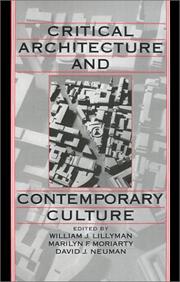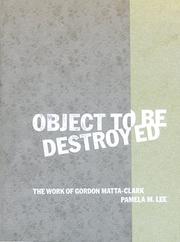| Listing 1 - 4 of 4 |
Sort by
|

ISBN: 0195078195 9780195078190 0195360168 9780195360165 9780195360165 1280526416 9781280526411 9786610526413 6610526419 1429405597 0197723616 Year: 1994 Publisher: New York : Oxford University Press,
Abstract | Keywords | Export | Availability | Bookmark
 Loading...
Loading...Choose an application
- Reference Manager
- EndNote
- RefWorks (Direct export to RefWorks)
This volume, evolving from a recent symposium, brings together a group of prominent literary theorists and architects to discuss the entente between postmodernism and architecture.
Deconstructivism (Architecture) --- Deconstructivisme (Architectuur) --- Déconstructivisme (Architecture) --- Architecture, Modern --- Déconstructivisme (Architecture) --- Architecture --- Architecture, Deconstructivist --- Deconstructionism (Architecture) --- Deconstructivist architecture --- History --- Architecture [Modern ] --- 20th century

ISBN: 0262278073 058527858X 9780585278582 0262122200 9780262278072 9780262122207 Year: 2000 Publisher: Cambridge, MA : MIT Press,
Abstract | Keywords | Export | Availability | Bookmark
 Loading...
Loading...Choose an application
- Reference Manager
- EndNote
- RefWorks (Direct export to RefWorks)
"Although highly regarded during his short life - and honored by artists and architects today - the American artist Gordon Matta-Clark (1943-78) has been largely ignored within the history of art. Matta-Clark is best remembered for site-specific projects known as "building cuts." Sculptural transformations of architecture produced through direct cuts into buildings scheduled for demolition, these works now exist only as sculptural fragments, photographs, and film and video documentations. Matta-Clark is also remembered as a catalytic force in the creation of SoHo in the early 1970s. Through loft activities, site projects at the exhibition space 112 Greene Street, and his work at the restaurant Food, he participated in the production of a new social and artistic space."--BOOK JACKET. "In this first critical account of Matta-Clark's work, Lee considers it in the context of the art of the 1970s - particularly site-specific, conceptual, and minimalist practices - and its confrontation with issues of community, property, the alienation of urban space, the "right to the city," and the ideologies of progress that have defined modern building programs."--Jacket.
Deconstructivism (Architecture) --- Visual Arts --- Art, Architecture & Applied Arts --- Visual Arts - General --- Architecture, Deconstructivist --- Deconstructionism (Architecture) --- Deconstructivist architecture --- Architecture, Modern --- Influence. --- Influence --- Matta-Clark, Gordon, --- Matta-Clark, Gordon --- Matta-Clark, G. --- Criticism and interpretation.
Book
ISBN: 1438469373 9781438469379 9781438469355 Year: 2018 Publisher: Albany, [New York] : SUNY Press,
Abstract | Keywords | Export | Availability | Bookmark
 Loading...
Loading...Choose an application
- Reference Manager
- EndNote
- RefWorks (Direct export to RefWorks)
Between 1984 and 1994 Jacques Derrida wrote and spoke a great deal about architecture both in his academic work and in connection with a number of particular building projects around the world. He engaged significantly with the work of architects such as Bernard Tschumi, Peter Eisenman, and Daniel Libeskind. Derrida conceived of architecture as an example of the kind of multidimensional writing that he had theorized in Of Grammatology, identifying a rich common ground between architecture and philosophy in relation to ideas about political community and the concept of dwelling. In this book, Francesco Vitale analyzes Derrida's writings and demonstrates how Derrida's work on this topic provides a richer understanding of his approach to deconstruction, highlighting the connections and differences between philosophical deconstruction and architectural deconstructivism.
Architecture --- Deconstructivism (Architecture) --- Architecture, Deconstructivist --- Deconstructionism (Architecture) --- Deconstructivist architecture --- Architecture, Modern --- Philosophy. --- Derrida, Jacques. --- Derrida, Jacques --- Derrida, J. --- Derida, Žak --- Derrida, Jackes --- Derrida, Zhak --- Deridah, Z'aḳ --- Deridā, Jāka --- Dirīdā, Jāk --- Деррида, Жак --- דרידה, ז'אק
Book
ISBN: 0262286203 0585003343 9780585003344 9780262286206 Year: 1993 Publisher: Cambridge, Mass. : MIT Press,
Abstract | Keywords | Export | Availability | Bookmark
 Loading...
Loading...Choose an application
- Reference Manager
- EndNote
- RefWorks (Direct export to RefWorks)
In this book Wigley redefines the question of deconstruction and architecture. By locating the architecture already hidden within deconstructive discourse, he opens up more radical possibilities for both architecture and deconstruction, offering a way of rethinking the institution of architecture while using architecture to rethink deconstructive discourse. Wigley relentlessly tracks the tacit argument about architecture embedded within Jacques Derrida's discourse, a curious line of argument that passes through each of the philosopher's texts. He argues that this seemingly tenuous thread actually binds those texts, acting as their source of strength but also their point of greatest weakness. Derrida's work is seen to render architecture at once more complex, uncanny, pervasive, unstable, brutal, enigmatic, and devious, if not insidious, while needing itself to be subjected to an architectural interrogation. Wigley provocatively turns Derrida's reading strategy back on his texts to expose the architectural dimension of their central notions like law, economy, writing, place, domestication, translation, vomit, spacing, laughter, and dance. Along the way he highlights new aspects of the relationship between Heidegger and Derrida, explores the structural role of ornament and the elusive architecture of haunting, while presenting a fascinating account of the institutional politics of architecture.
Deconstruction (Architecture) --- Deconstructivism (Architecture) --- Architecture --- Art, Architecture & Applied Arts --- Architecture, Deconstructivist --- Deconstructionism (Architecture) --- Deconstructivist architecture --- Architecture, Modern --- Philosophy. --- Derrida, Jacques --- Derrida, Jacques. --- Derrida, J. --- Derida, Žak --- Derrida, Jackes --- Derrida, Zhak --- Deridah, Z'aḳ --- Deridā, Jāka --- Dirīdā, Jāk --- Деррида, Жак --- דרידה, ז'אק
| Listing 1 - 4 of 4 |
Sort by
|

 Search
Search Feedback
Feedback About UniCat
About UniCat  Help
Help News
News